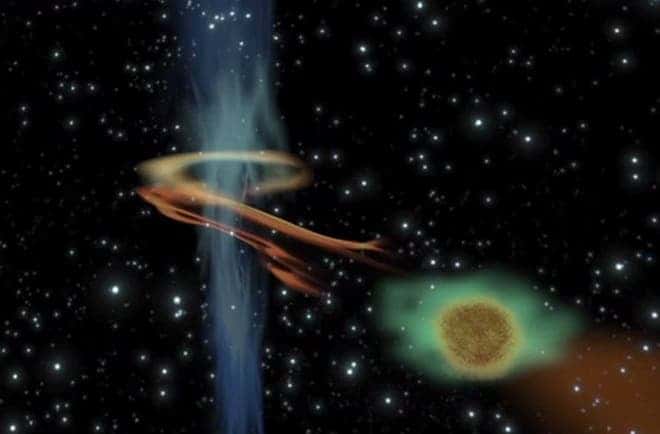
In an unexpected discovery, astronomers have surprised a supermassive black hole that had been dormant for the past decades “waking up” and feasting upon an unsuspecting planet that had drifted too close to its event horizon. The mass of the planet hints towards a giant Jupiter or a small brown dwarf. Also, a similar event is set to take place in our galaxy soon, after observations of the supermassive black hole lying at the center of our own galaxy showed that it will engage in a similar feeding event, albeit on a gas cloud.
The event was picked-up by the European INTEGRAL space observatory, which surveys the cosmos for high-energy emissions of gamma-rays and X-rays. At the time, INTEGRAL was studying a different galaxy, but a sudden energy flare at NGC 4845, a spiral galaxy some 47 million light-years away, caught the attention of astronomers and it could mean only one thing – the supermassive black hole deep in the galaxy’s bawls had woken up after more than 30 years. Follow-up observations from ESA’s XMM-Newton, NASA’s Swift and Japan’s MAXI X-ray monitor on the International Space Station confirmed the finding.
Technically however there’s no such thing as an inactive black hole, but what the researchers describe through this “hibernation” metaphor is a lack of feeding over a long period of time.
“The observation was completely unexpected, from a galaxy that has been quiet for at least 20–30 years,” said Marek Nikolajuk of the University of Bialystok, Poland, lead author of the research published in the journal Astronomy & Astrophysics.
By analyzing the intensity and duration of the feeding, which peaked in January 2011 and then slowly subsided over the course of a year, the astronomers could infer the mass of the black hole’s meal. Subsequent analysis showed that the object must have been somewhere in the mass range of 14–30 Jupiter masses, consisting with a giant nomad planet (planet’s that stray and travel through interstellar space) or a brown dwarf (substellar objects that are not massive enough to fuse hydrogen in their core and ignite as stars).
A sleeping giant just woke up and it’s damn hungry
The black hole wasn’t just satisfied with having a hefty meal, however. It toyed with its preyed and tormented it, as analysis showed X-ray emissions fluctuated over 2-3 months, suggesting the object passed close, suffered some extreme tidal shear, causing layers of gas to be ripped away before the whole thing was finally consumed. If you’re interested, ESA has a video simulation of the event here.
“This is the first time where we have seen the disruption of a substellar object by a black hole,” said co-author Roland Walter of the Observatory of Geneva, Switzerland.
“We estimate that only its external layers were eaten by the black hole, amounting to about 10% of the object’s total mass, and that a denser core has been left orbiting the black hole.”
According to the researchers, the flaring event in NGC 4845 was a warm-up for a more interesting “black hole in action” study, right in our backyard. Later this year, the Milky Way’s supermassive black hole is expected to commence feeding on a straying giant gas cloud. The cloud is already suffering extreme disruption and is expected to meet its end soon enough. By studying events such as NGC 4845’s flaring or the upcoming gas cloud gobbling by our closest supermassive black hole, scientists can deepen our understanding and learn new things about what happens to cosmic objects as they encounter black holes of various sizes.
“Estimates are that events like these may be detectable every few years in galaxies around us, and if we spot them, Integral, along with other high-energy space observatories, will be able to watch them play out just as it did with NGC 4845,” added Christoph Winkler of the European Space Agency (ESA).






